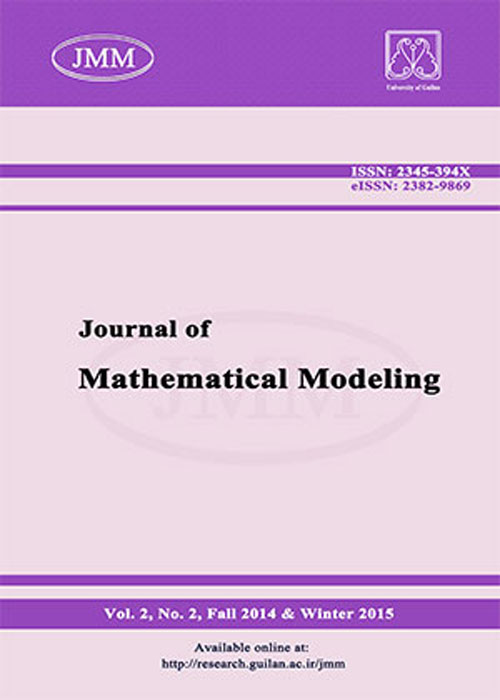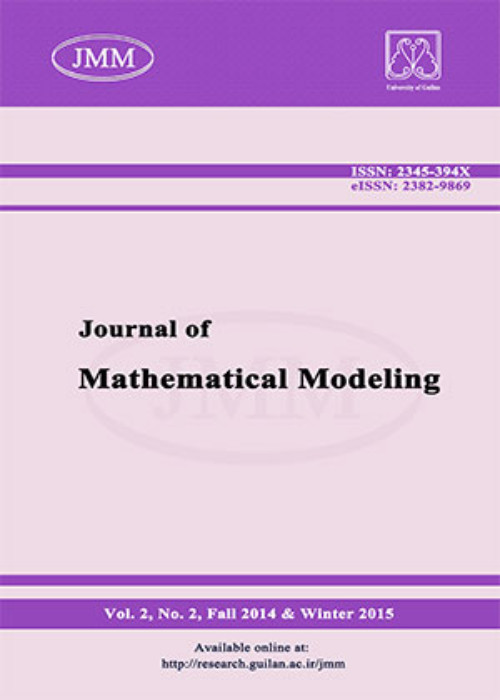فهرست مطالب

Journal of Mathematical Modeling
Volume:7 Issue: 3, Summer 2019
- تاریخ انتشار: 1398/06/10
- تعداد عناوین: 7
-
Pages 263-276The occurrence of horseshoe chaos in Duffing oscillator with fractional damping and multi-frequency excitation is analyzed by using analytical and numerical techniques. Applying Melnikov method, analytical threshold condition for the onset of horseshoe chaos is obtained. The effect of damping exponent and the number of periodic forces on the dynamics of the Duffing oscillator is also analyzed. Due to fractional damping and multi-frequency excitation, suppression of chaos and various nonlinear phenomena are predicted. Analytical predictions are demonstrated through numerical simulations.Keywords: Duffing oscillator, Fractional damping, Horseshoe chaos, Melnikov meth- od, Multi-frequency excitation
-
Pages 277-285A new weak Galerkin finite element method is applied for time dependent Brusselator reaction-diffusion systems by using discrete weak gradient operators over discontinuous weak functions. In this work, we consider the lowest order weak Galerkin finite element space $(P_{0},P_{0},RT_{0})$. Discrete weak gradients are defined in Raviart-Thomas space. Thus we employ this approximate space on triangular mesh for solving unknown concentrations $ (u,v)$ in Brusselator reaction-diffusion systems. Based on a weak varitional form, semi-discrete and fully-discrete weak Galerkin finite element scheme are obtained. In addition, the paper presents some numerical results to illustrate the power of proposed method.Keywords: Weak Galerkin finite element method, Reaction-diffusion system, Weak gradient
-
Pages 287-304This study attempts to estimate the volatility of the American options pricing model under jump-diffusion underlying asset model. Therefore, the problem is formulated then inverted, and afterward, direct finance problems are defined. It is demonstrated, then, that the price of this type of options satisfies a free boundary Partial Integral Differential Equation (PIDE). The inverse method for estimating the volatility and the American options price is also described in three phases: first, transformation of the direct problem to a non-linear initial and boundary value problem. Second, finding the solution by using the method of lines and the fourth-order Runge-Kutta method.Third, presenting a minimization function with Tikhonov regularization.Keywords: Emden-Fowler equations, integral equation, Volterra, moving least squares method
-
Pages 305-318In this article, we shall establish sufficient conditions for the existence of mild solutions for second order semilinear integro-differential evolution equations in Fre'chet spaces $C(mathbb{R}_+ , E)$, where $E$ is an Banach space. Our approach is based on the concept of a measure of noncompactness and Tykhonoff fixed point theorem. For illustration we give an example.Keywords: Semilinear integro-differential equation, measure of noncompactness, mild solutions, evolution system, Tykhonoff fixed point theorem
-
Pages 319-336Global approaches make troubles and deficiencies for solving singularly perturbed problems. In this work, a local kernel-based method is applied for solving singularly perturbed parabolic problems. The kernels are constructed by the Newton basis functions (NBFs) on stencils selected as thin regions of the domain of problem that leads to increasing accuracy with less computational costs. In addition, position of nodes may affect significantly on accuracy of the method, therefore, the adaptive residual subsampling algorithm is used to locate optimal position of nodes. Finally, some problems are solved by the proposed method and the accuracy and efficiency of the method is compared with results of some other methods.Keywords: Local kernel-based method, Newton basis functions, adaptive residual subsampling algorithm, singularly perturbed parabolic problems, convection-diffusion problems
-
Pages 337-355The main purpose of this work is to give a generalization of the Subspace Iteration Method to compute the largest eigenvalues and their corresponding eigenvectors of the matrix pencil $A-lambda B$. An effective single shift procedure is given. Several numerical experiments are presented to illustrate the effectiveness of the proposed methods.Keywords: Matrix pencil, Generalized eigenvalues, Generalized QR-Francis, Generalized Subspace Iteration Method
-
Pages 357-379This paper is devoted to the study of the Sin-G class of distributions and one of its special member. We first explore the mathematical properties of the Sin-G class, giving the cumulative and probability density functions and their expansions, quantile function, moments, moment generating function, reliability parameter, R'enyi entropy and order statistics. Then, we focus our attention on the special member defined with the Inverse Weibull distribution as baseline, denoted by SinIW. The mathematical and practical aspects of the SinIW distribution are investigated. In order to illustrate the usefulness of the SinIW model, an application to real life data set is carried out.Keywords: classes of trigonometric sine distributions, inverse Weibull distribution, maximum likelihood estimation, data analysis


